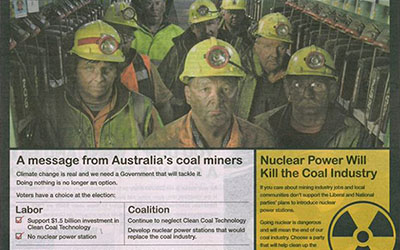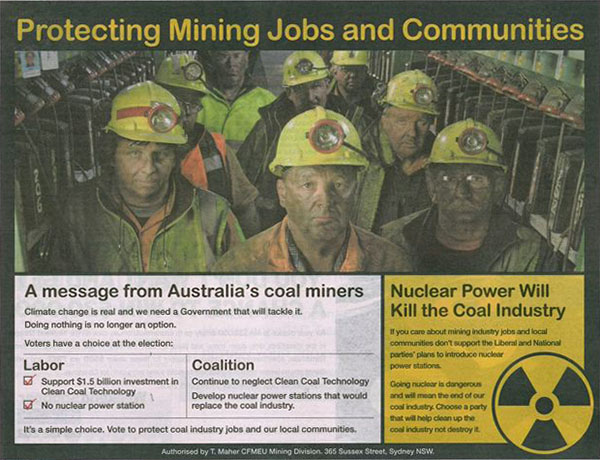Yes-we-can clean energy ministerial


Dirty Guilt-Trip: The industry that kills nearly a million a year names its worst nightmare. advertisement Construction, Forestry, Mining and Energy Union
The green stars of the show are set to be the Arabs and the Koreans.
South Korea is spending a greater percentage of its economic recovery stimulus on green initiatives than any country in the world.
And the United Arab Emirates is investing heavily in renewable energy projects—presumably why Abu Dhabi was chosen interim headquarters of the new International Renewable Energy Agency.
The two countries will be joined by a further 15 of the world’s largest economies at a clean energy ministerial in Washington in two weeks time.
The timing of the ministerial is monstrously fortuitous. The host country’s fossil fuel industry is literally haemorrhaging dirty energy, and its president has determinedly nailed his clean energy colours to White House flagpole.
From Lyndon B Johnson onward, all United States presidents have talked about the need to end the oil addiction but none has acted. Even Al Gore wimped out during his wooden bid for the presidency, suddenly saying it was all about the economy—stupidly.
President Barack H Obama could prove to be the most courageous president since John F Kennedy. Kennedy had the courage to negotiate with Nikita S Khrushchev and bring humanity back from the brink of nuclear extinction. Neither Kennedy nor Khrushchev would have dreamed humanity would risk extinction again so soon simply because a self-interested fossil fuel industry had become more powerful than the two cold war superpowers put together.
It is impossible to prove when runaway greenhouse effect will kick in, or that it hasn’t already. All that can be said with reasonable certainty is that, in spite of the warnings that worried President Johnson in 1965, fossil fuel use continues to accelerate and that there are sufficient fossil fuel reserves to enable greenhouse gas levels to be elevated to the point where life would resemble that on Venus: Absent.
While the president’s energy secretary, Dr Stephen Chu, predicts it’ll take another 100 to 150 years for this apocalypse to play out. He further says:
It’s not too late; we can minimize the alteration, or we can just plough on as usual. And if we plough on as usual, it could be very, very bad.

Sound Advice: Presidential science advisor Alvin Weinberg saw nuclear power as essential in limiting anthropogenic global warming. photographer Ed Westcott
Dr Chu, as head of the US Department of Energy, is hosting the Major Economies Forum on Energy and Climate’s inaugural clean energy ministerial. The agenda ‘will focus on concrete steps forward to promote clean energy’; there appears to be mercifully little preoccupation with emissions trading. The forum has produced 12 technology-focused action plans led by different countries. Canada, for example heads up advanced vehicles; Denmark, Germany, and Spain head up wind energy.
Ironically, given Chu’s advocacy of it, nuclear power is not the subject an action plan. Intriguingly, China is not the leader of an action plan.
China is simultaneously building 16 third-generation reactors. This is demonstrably clean energy particularly when compared with coal combustion, which kills almost a million people per year and sickens billions.
Next year, Russia is building China two fourth-generation reactors. Fourth generation technology is the solution to existing nuclear waste and surplus weapons plutonium. And these reactors have been demonstrated to be failsafe—designed to gently shut down when the lights go out.
But clean?
Third and fourth-generation power plants are, compared to background levels of radiation and particularly compared to fly ash. Coal contains uranium and thorium, which is concentrated in the ash produced by power plants. Thus it is calculated that coal-fired plants produce a hundred times more radiation than a nuclear plant for a given power output.
Coal burning gets two action plans—one for carbon dioxide capture; one for high-efficiency, low-emission technology. Neither of these areas is particularly promising, even the coal industry has spent virtually nothing on ‘clean coal’—coal is simply too dirty and releases too much carbon dioxide. China, appears to recognise this and prefers to be more strategic. In the United States, in contrast, the all-powerful coal industry is practically immune from regulation. The government is throwing billions into subsidising carbon capture to prove to the electorate that it is reasonable to lean on the industry. This is the price for allowing ascendancy of the market over the democratic will of the people—the rights of the coal industry over the billions sickened or killed by it, never mind the viability of life itself. Incredibly, the self-interest of the coal industry stretches to it being anti-nuclear.
With the ministerial being held in Washington, and the Gulf of Mexico awash in oil, it now up to its president to ensure the United States emulates the efforts of South Korea and the United Arab Emirates.
May Dr Chu be heard above the disingenuous din of a thousand fossil fuel lobbyists.
Global Warming and Nuclear Power
Stewart Brand: Whole Earth Discipline
Barry Brook: Why vs Why Nuclear Power
James Hansen: Australia Was Not Ready for James Hansen
Mark Lynas: Why No Party Can Afford to be Anti-Nuclear
Alvin Weinberg: Prophet of CO2‑Driven Global Warming
